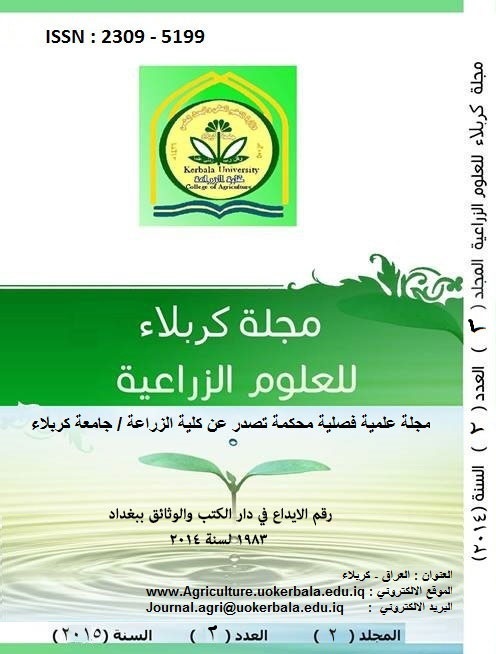Role of Organic and Chemical Nutrients in Growth and Yield of Eggplant under protected cultivation
DOI:
https://doi.org/10.59658/jkas.v2i2.496Abstract
An experiment was conducted in plastic house units – Horticulture department – College of Agriculture – Baghdad University (Abu Ghraib) during 2011 – 2012 and 2012 – 2013 growing seasons aimed to study the effect of organic and chemical fertilizers on growth and production of eggplant(Hybrid Barcelona). Randomized complete block design (RCBD) with three replicates were used. An experiment contained 14 treatments, the treatments without fertilization (A1) and chemical fertilizer as recommended (NPK) with manure at a rate of 5 % of soil volume(A2)were considered as contral. So, the treatments Results of other treatments(12 treatments) compared with them, six treatments (level of organic fertilizer Biotron S + level of chemical fertilizer NPK) were A3 (100% +50%), A4 (100% + 0%), A5 (150% + 50%), A6 (150% + 0%), A7 (200% + 50%) and A8 (200% +0%). and six treatments like them with spray organic fertilizer Vegeamino (1 ml.L-1) were A9, A10, A11, A12, A13 and A14 sequentially.
The results of An experiment showed that reduced level of chemical fertilizer in the two treatments(A13 and A11) and chemical fertilizer as recommended (A2) gave the highest increases in percentage or concentration of N, P and K in the leaves. The treatments A13, A11, A9 and A2 gave a significant increases in most characteristics such as vegetative, flowery, yield and quality of fruits compared with most other treatments. The treatment(A13) was recorded as the best treatment among treatment combinations on number of leaves and chlorophyll content of leaves(second season). It’s distinguished with values of number of flower clusters(trusses) per plant, length of fruit and number of fruit that were not significant with the highest values recorded in A2 treatment in that characters. A13 treatment also gave the highest values in yield of plant with an increment of 160.8% in first season as compared with the control(A1) whereas in second season it’s gave values were close to highest values in above characters given by A2 treatment with an increment of 135.5% as compared with the control(A1).The highest significant total soluble solids for both seasons and anthocyanin content in the rind(first season)were obtained from A2 treatment whereas at second season A13 treatment gave the highest increase.
Downloads
Published
How to Cite
Issue
Section
License
Copyright (c) 2015 Copyright (c) 2024 is the Author's article. Published by the Journal of Kerbala for Agricultural Sciences under a CC BY 4.0 license

This work is licensed under a Creative Commons Attribution 4.0 International License.
Licensing Terms
All articles are published under a Creative Commons License and will be directed to the Creative Commons Attribution 4.0 International License (CC BY 4.0) That permits use, distribution, and reproduction in any medium, provided the original work is properly cited. This license also allows the work to be used for commercial purposes.
Use by both non-commercial and commercial users
This content is licensed under a Creative Commons Attribution 4.0 International (CC BY 4.0) license, permitting use by both non-commercial and commercial users. Individual users may access, download, copy, display, and redistribute the articles to colleagues, as well as adapt, translate, and text- and data-mine the content, subject to the following conditions:
- The author's moral rights, including the right of attribution and the right to protect their work from derogatory treatment, are respected.
- Where content in the article is identified as belonging to a third party, users must ensure that any reuse complies with the copyright policies of the owner of that content.
- If the article content is reused for research or educational purposes, users should maintain a link to the appropriate bibliographic citation, including the DOI and a link to the published version on the journal's website.

